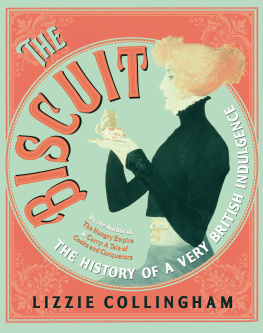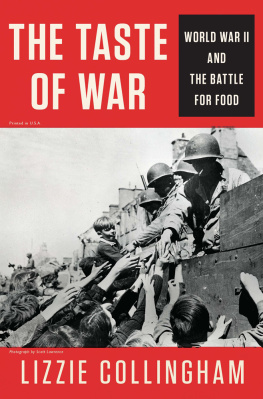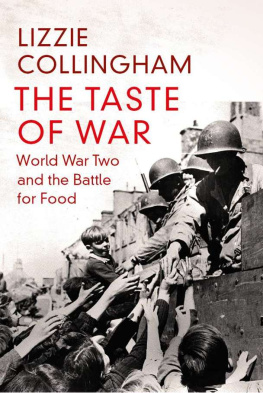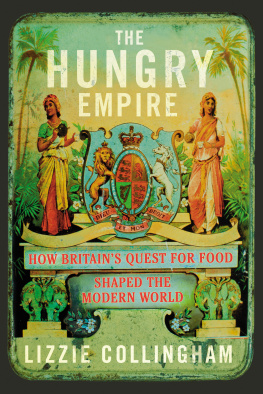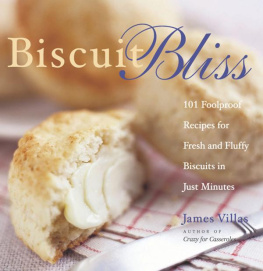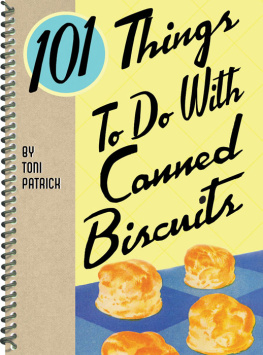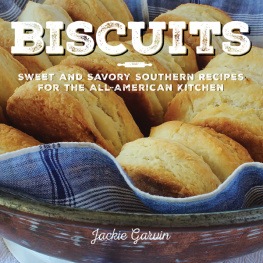

Lizzie Collingham
The Biscuit

The History of a Very British Indulgence

ABOUT THE AUTHOR
Lizzie Collingham taught History at Warwick University and was a Research Fellow at Jesus College, Cambridge before becoming an independent historian. Her books include Curry: A Tale of Cooks and Conquerors and The Taste of War: World War II and the Battle for Food. She is currently an Associate Fellow of Warwick University and the Royal Literary Fund Fellow at Newnham College, Cambridge. She recently completed a project researching the history of the kitchens of the Indian Presidents palace and regularly lectures on a gastronomic tour of Kerala. She works in a garden shed near Cambridge.
BY THE SAME AUTHOR
Imperial Bodies: The Physical Experience of the Raj, c.18001947
Curry: A Tale of Cooks and Conquerors
The Taste of War: World War II and the Battle for Food
The Hungry Empire: How Britains Quest for Food Shaped the Modern World
For Sophie Calypso

To make Bisket Bread Stif
Put to a pound of flower half a pound of sugar, nyne whites and six yelks of eggs, finelie beaten, mould it together, & make it up in a roule to bake it, when it is baked slice it & drie it, in the oven on a gredyron, you must put in some anniseeds, & coriander in the moulding.
Lady Elinor Fettiplaces manuscript cookbook
LIST OF ILLUSTRATIONS

Ancient Roman bread, Pompeii. Alamy Stock Photo.
Andrea Mantegna, The Circumcision (1462). Alamy Stock Photo.
Wafers made by Ivan Day with a set of early-seventeenth-century English wafering irons. Reproduced by kind permission of Ivan Day.
Frontispiece for Hannah Woolley, The Queen-like Closet, or Rich Cabinet: stored with all manner of rare receipts for preserving, candying and cookery. Very pleasant and beneficial to all ingenious persons of the female sex (1675). LUNA Folger Digital Image Collection, The Folger Shakespeare Library.
Jan van Halbeeck, Vrouw bij een schaal lekkernijen (16101680). Rijksmuseum. Amsterdam.
William Hogarth, The idle prentice executed at Tyburn (1747). The Lewis Walpole Library, Yale University Library.
Emigrant and pretzel vendor, New York. The Library of Congress, Washington DC.
Migrant mother making biscuits in her tent home, Mercedes, Texas. Library of Congress, Washington DC.
Jean Charles Devell, Les Biscuits: scene in a pastry shop, design in progress for a painted porcelain plate, rondel, for the Service des objets de dessert (1783), Svres porcelain manufactory, France. Cooper Hewitt, Smithsonian Design Museum.
Mould for making House of York toasting biscuits to celebrate the wedding of the Duke and Duchess of York, England, c.1790, unidentified wood, Fitzwilliam Museum, Cambridge.
Sketches in a biscuit manufactory (1874). Private collection.
Huntley & Palmers trade card. Private Collection.
Advertisement for Hendersons Digestive Pufnels (c.19001930). Private collection.
International Health Exhibition, Peek Frean (1884). Private collection.
Huntley & Palmers Breakfast Biscuits (1907). Private collection.
Interior of W. S. Dustins confectionery shop in Wanganui, 1909, photograph by Frank J. Denton. Alexander Turnbull Library, Wellington, New Zealand.
British Army soldiers suffering from frostbite lying on hay in a shelter made from Huntley & Palmers biscuit boxes at Suvla, Gallipoli Peninsula, Turkey, 1915. Australian War Memorial, Canberra, Australia.
Emboitage des Petit-Beurre Extra: Biscuits Olibet, postcard. Private collection.
Soldiers with military supplies in a French farmyard, Bus-ls-Artois, 21 April 1918, photograph by Henry Armytage Sanders. Alexander Turnbull Library, Wellington, New Zealand.
El Agheila, Cyrenaica, Libya, 7 December 1942. Australian War Memorial, Canberra, Australia.
S. W. Fores, Genuine Tea Company (1825). Lewis Walpole Library, Yale University Library.
Profile of a young woman reading a book and eating. Everett Collection/Bridgeman Images.
Bread distribution, Roman fresco from the Praedia of Julia Felix in Pompeii. Museo Archeologico Nazionale (Naples), The Picture Art Collection/Alamy Stock Photos.
Theriaca, an illustration from Ibn Butlans eleventh-century Taqwim al-sihhah or Maintenance of Health, published in Italy as the Tacuinum Sanitatis in the fourteenth century. CPA Media Pte Ltd/Alamy Stock Photo.
Andrea Mantegna, The Circumcision (1462). Alamy Stock Photo.
Alexander Hugo Bakker Korff (c.18501882), The Waffle Maker. Rijksmuseum, Amsterdam.
Recreation of an English Renaissance sugar banquet for a wedding, c.1610, conceived and made by Ivan Day, consisting of replicas of wafers, rolled and flat, pressed from seventeenth-century wafering iron; alphabet jumbles; knotted jumbles. Fitzwilliam Museum, Cambridge.
Gingerbread mould with pressings of gingerbread figures, by Ivan Day, 2019. Fitzwilliam Museum, Cambridge.
William Hogarth, Evening La Sore, 23 June 1740. Lewis Walpole Library, Yale University Library.
Jan Havickszoon. Steen, The baker Arent Oostward and his wife, Catharina Keizerswaard (1658). Rijksmuseum, Amsterdam.
Mate to Le grand dessert, print (1879). Library of Congress, Washington DC.
A selection of Huntley & Palmers trade cards. Private collection.
Huntley & Palmers Biscuit Factory, Reading, advertising postcard. Private Collection.
McVitie & Price biscuit tin. Private Collection.
McVities Digestive biscuits at any time of the daily round (1936). Chronicle/Alamy Stock Photos.
PREFACE

On 28 April 1789 William Bligh and 18 of his crew were set adrift in the Bountys longboat in the Tongan archipelago. The mutineers supplied them with a sextant, a compass, nautical tables, a tool box and 150 lb of biscuit, 20 lb of salt pork, 3 bottles of wine, 5 quarts of rum and 28 gallons of water. Bligh and his mens attempt to find more provisions on a nearby island ended in disaster when the islanders killed the quartermaster, John Norton. They decided their best option was to make their way to the nearest European outpost, the Dutch settlement of Kupang on the island of Timor, 4,000 miles to the west. To make this journey they would each have to ration themselves to a quarter of a pint of water and an ounce of biscuit a day.
More than 200 years later I found myself in a similar predicament on a small island overlooking the same stretch of sea. We had booked a home stay on the tiny island of Uiha, only to be told when we arrived that our hosts had been possessed by an evil spirit and taken to see an exorcist on another island. An islander came to show us the makeshift kitchen and our sleeping hut, told us to make ourselves at home and then left us to our own devices. A search through the kitchen cupboards turned up a tin of tuna, plenty of tea and some bananas. We had brought with us a loaf of bread and half a dozen packets of Marie biscuits. Unfortunately, the bread was devoured by ants as we did not think to put it in the insect-proofed cupboard. We realised that we would have to ration ourselves to 28 biscuits a day.
Next page
